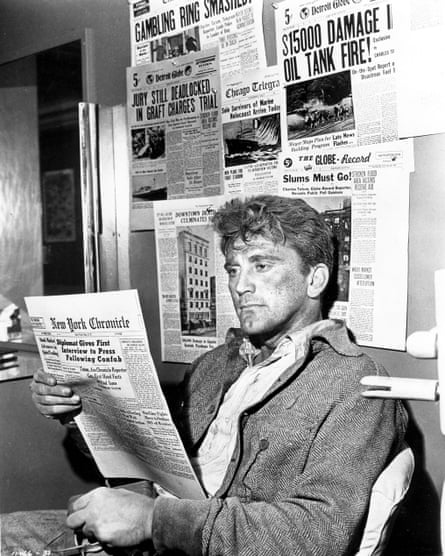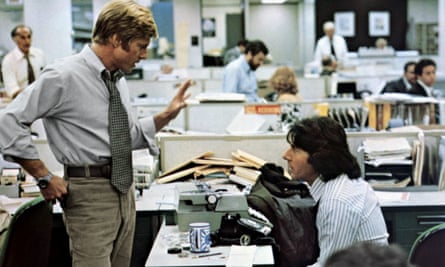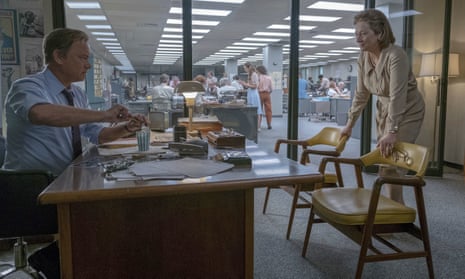Meryl Streep steps nimbly between two worlds in Steven Spielberg’s tense new film The Post, set in the Washington of the 1970s. Dressed in a businesslike twinset, she must handle a male-dominated newspaper boardroom, then by night become the consummate society hostess, marshalling guests and domestic staff around her elegant home in a couture kaftan.
Streep plays Katharine “Kay” Graham, the rich, real-life widow who was handed control of the Washington Post after the death of her publisher father and the suicide of her husband.
Spielberg’s film, out in Britain on 19 January, shows Graham finding her feet in the treacherous world of political journalism, but is also a stirring anthem for press freedom. Graham’s decision to print extracts from the top secret Pentagon Papers about Vietnam, leaked by defence analyst Daniel Ellsberg in 1971, initially put the financial future of the Post in jeopardy, yet marked a turning point in attitudes to government. “We are not a little local paper any more,” declares gleeful editor Ben Bradlee, played by Tom Hanks, once the presses finally roll.
Although its rival, the New York Times had, in truth, broken the story, the Post weighed in quickly, at some risk, and was later to lead the pack with its coverage of Watergate, courtesy of Bob Woodward and Carl Bernstein.
While Streep’s character is at the centre of the plot, much of the drama takes place in the newsroom. So The Post is soon to join a fine tradition of compelling newspaper films: a line of cinematic hits setting out either to celebrate the reporter’s honourable role in a democracy, or revel in the dirty tricks of the trade. And sometimes to do both. Much like the police, reporters are widely distrusted in the real world, but they do make handy screen protagonists. The Hollywood ideal has to be the cynical reporter played by Clark Gable, on the trail of his celebrity story in Frank Capra’s charming It Happened One Night (1934). Serious romantic competition could come only from Gregory Peck’s reporter in pursuit of his truanting princess in Roman Holiday (1953).
But a newspaperman’s hunt for a story has also given shape to plenty of murky thrillers, whether based on fact, like The Post and, most notably, All the President’s Men (1976), or based on nothing more than imaginative neurosis, like the acclaimed British outing, Defence of the Realm. This dark 1986 film, which starred Gabriel Byrne as an investigative reporter, compared well with All the President’s Men for the leading American critic Roger Ebert, but was “a bleaker, more pessimistic movie”.

And it still holds up next to another, better-known political fantasy: Alan J Pakula’s The Parallax View, released in 1974 and starring Warren Beatty as political reporter Joe Frady. The film’s prevailing paranoia was seen as a symptom of declining trust in the American political establishment. Newsmen – and even the occasional newswoman – have been centre stage in Hollywood from the early days, partly because so many screenwriters had a background in journalism. The former reporter Ben Hecht first successfully adapted his play The Front Page for the screen in 1931 and it was later remade with Cary Grant and Rosalind Russell as His Girl Friday – and then again under the original title with Jack Lemmon and Walter Matthau. Each version offers a quaint portrait of the rivalry between newspapers as well as between reporters in the same newsroom.
Newspaper investigations recur as a neat frame for storytelling in cinema. Perhaps the most exalted example is the search for the meaning of Rosebud in Citizen Kane, but on a rather more camp register the job also allows the bespectacled Clark Kent of the Daily Planet to travel around America with his photographer sidekick in the Superman films.
The search for a big story helpfully takes a lead character into the heart of events in a way only otherwise credible for a private detective. So Hitchcock’s 1940 thriller Foreign Correspondent propelled hardboiled American crime reporter Joel McCrea off to Europe in search of spies, while in 1984 the Bafta-winning The Killing Fields sent Sam Waterston off to file from Cambodia only shortly after The Year of Living Dangerously had seen Mel Gibson posted out to Indonesia by director Peter Weir, in what remains a critics’ favourite in the crumpled-linen-suit school of screen reporting. Spielberg clearly has a particular feeling for the embedded journalist working on the frontline. The scene showing the typewriter Ellsberg carries with him “in country” at the opening of The Post harks back to scenes in his own earlier blockbuster, Saving Private Ryan.
But more often than not a newspaper “hack” simply provides a bit of seedy colour. Disreputable reporters put the grit in the oyster of a flimsy comic plot like The Philadelphia Story of 1940, remade as the musical High Society, just as the sinister shadow of Burt Lancaster’s columnist JJ Hunsecker looms over Alexander MacKendrick’s 1957 triumph, Sweet Smell of Success. Meanwhile, in Fellini’s La Dolce Vita, the name of a supporting character, the persistent street photographer Paparazzo, subsequently came to describe a whole phalanx of the popular press.
Other film directors have fallen for the magic of producing a newspaper. Early Hollywood classics such as Deadline USA or Five Star Final, along with the 1994 comedy The Paper, delight in pitting journalists and proprietors against a ticking clock. All the same, reporting can be tricky to dramatise visually and, just as police officers in films seem unable to work without a wall of photographs and arrows, so screen reporters spend a lot of time crowded around a computer terminal. In the cinema, reporters and cops are also all too frequently given “just 24 hours”.
In recent years journalists have appeared powerfully on film either calling power to account or releasing shocking national secrets in collaboration with real-life whistleblowers. The Insider played by Russell Crowe in 1999 was the real source for television revelations about the tobacco industry, while the Guardian’s part in handling both Julian Assange’s WikiLeaks revelations and the Edward Snowden National Security Agency leaks were represented respectively in The Fifth Estate in 2013 and in last year’s Oliver Stone thriller, Snowden.
In many Hollywood classics, from The Man Who Shot Liberty Valance to All the President’s Men, the choices made by a newspaper editor are pivotal. Director John Ford’s newspaperman in the 1962 western famously discards his notebook and opts “to print the legend”, while in Pakula’s Watergate saga of 1976 the Post’s editor Bradlee, this time played to Oscar-winning effect by Jason Robards, eventually backs the coverage that will expose Nixon.
Some great newspaper films focus more closely on the morality of the individual reporter. The screenplay of Spotlight, which won awards in 2016, salutes the dogged doorstepping of the team at the Boston Globe as they put together the picture of sexual abuse in the Roman Catholic church. The journalists are sensitive in their handling of contacts, pushing for more, but only to make their story clearer. By contrast, in Absence of Malice in 1981, the inexperience of Sally Field’s reporter puts Paul Newman in danger, while, at the very worst end of the scale, Ace in the Hole (1951) brilliantly charts the moral decline of a ruthless newsman played by Kirk Douglas.
It might seem an odd moment to celebrate the press. For although reporters have always existed on the edge of social acceptability, they are now especially demonised, both from the left and the right. Nevertheless, Streep and her co-star Hanks both agreed to make The Post for Spielberg as a swift response to the political atmosphere at the White House, where oppositional newspapers are again being offered limited access.
In America, the film’s contribution has been warmly welcomed by critics and newspaper executives. The review in Variety typically hailed it as “a movie of galvanising relevance” and predicted Oscar honours, while Len Downie, a former executive editor at the Washington Post, has judged: “This movie means a lot at this time in history.”

NEWSROOM CLASSICS
His Girl Friday (1940)
Reworking of Ben Hecht’s play The Front Page, starring Cary Grant and Rosalind Russell, centring on the sparring relationship between two reporters.
Ace in the Hole (1951)
Billy Wilder’s dark journey into the character of an ambitious and morally bankrupt reporting “ace”, played by Kirk Douglas, who bends the facts in order to achieve a ‘big scoop’ comeback.
All the President’s Men (1976)
Alan J Pakula’s lodestar for all newsroom thrillers, in which the Washington Post’s Carl Bernstein (Dustin Hoffman) and Bob Woodward (Robert Redford) unravel the truth about Nixon’s Watergate scandal.
The Paper (1994)
Glenn Close’s executive and Michael Keaton’s news editor battle to keep the fictional New York Sun afloat in Ron Howard’s comic requiem for the press.

Comments (…)
Sign in or create your Guardian account to join the discussion